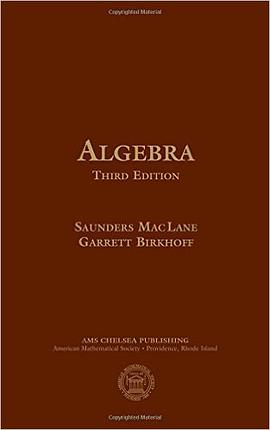Algebra
豆瓣
Saunders MacLane / Garrett Birkhoff
简介
This book presents modern algebra from first principles and is accessible to undergraduates or graduates. It combines standard materials and necessary algebraic manipulations with general concepts that clarify meaning and importance.
This conceptual approach to algebra starts with a description of algebraic structures by means of axioms chosen to suit the examples, for instance, axioms for groups, rings, fields, lattices, and vector spaces. This axiomatic approach--emphasized by Hilbert and developed in Germany by Noether, Artin, Van der Waerden, et al., in the 1920s--was popularized for the graduate level in the 1940s and 1950s to some degree by the authors' publication of A Survey of Modern Algebra. The present book presents the developments from that time to the first printing of this book. This third edition includes corrections made by the authors.
contents
Content
.
Preface to the Third Edition
.
From the Preface to the First Edition
.
From the Preface to the Second Edition
.
List of Symbols
.
I Sets, Functions, and Integers
1. Sets
2. Functions
3. Relations and Binary Operations
4. The Natural Numbers
5. Addition and Multiplication
6. Inequalities
7. The Integers
8. The Integer Modulo n
9. Equivalence Relation and Quotient Sets
10. Morphisms
11. Semigroups and Monoids
.
II Groups
1. Groups and Symmetry
2. Rules of Calculations
3. Cyclic Groups
4. Subgroups
5. Defining Relations
6. Symmetric and Alternating Groups
7. Transformation Groups
8. Cosets
9. Kernel and Image
10. Quotient Groups
.
III Rings
1. Axioms for Rings
2. Constructions for Rings
3. Quotient Rings
4. Integral Domains and Fields
5. The Field of Quotients
6. Polynomials
7. Polynomials as Functions
8. The Division Algorithms
9. Principal Ideal Domains
10 Unique Factorization
11. Prime Fields
12. The Euclidean Algorithm
13. Commutative Quotient Rings
.
IV Universal Constructions
1. Examples of Universals
2. Functors
3. Universal Elements
4. Polynomials in Several Variables
5. Categories
6. Posets and Lattices
7. Contravariance and Duality
8. The Category of Sets
9. The Category of Finite Sets
.
V Modules
1. Sample Modules
2. Linear Transformations
3. Submodules
4. Quotient Modules
5. Free Modules
6. Biproducts
7. Dual Modules
.
VI Vector Spaces
1. Bases and Coordinates
2. Dimensions
3. Construction for Bases
4. Dually Paired Vector Spaces
5. Elementary Operations
6. Systems of Linear Equations
.
VII Matrices
1. Matrices and Free Modules
2. Matrices and Biproducts
3. The Matrix of a Map
4. The Matrix of Composite
5. Ranks of Matrices
6. Invertible Matrices
7. Change of Bases
8. Eigenvalues and Eigenvectors
.
VIII Special Fields
1. Ordered Domains
2. The Ordered Field Q
3. Polynomial Equations
4. Convergence in Ordered Fields
5. The Real Field R
6. Polynomial over R
7. The Complex Plane
8. The Quaternions
9. Extended Formal Power Series
10. Valuations and p-adic Numbers
.
IX Determinants and Tensor Products
1. Multilinear and Alternating Functions
2. Determinants of Matrices
3. Cofactors and Cramer's Rule
4. Determinants of Maps
5. The Characteristic Polynomial
6. The Minimal Polynomial
7. Universal Bilinear Functions
8. Tensor Products
9. Exact Sequences
10. Identities on Tensor Products
11. Change of Rings
12. Algebras
.
X Bilinear and Quadratic Forms
1. Bilinear Forms
2. Symmetric Matrices
3. Quadratic Forms
4. Real Quadratic Forms
5. Inner Products
6. Orthonormal Bases
7. Orthogonal Matrices
8. The Principal Axis Theorem
9. Unitary Spaces
10. Normal Matrices
.
XI Similar Matrices and Finite Abelian Groups
1. Noetherian Modules
2. Cyclic Modules
3. Torsion Modules
4. The Rational Canonical Form for Matrices
5. Primary Modules
6. Free Modules
7. Equivalence of Matrices
8. The Calculation of Invariant Factors
.
XII Structure of Groups
1. Isomorphism Theorems
2. Group Extensions
3. Characteristic Subgroups
4. Conjugate Classes
5. The Cylow Theorems
6. Nilpotent Groups
7. Solvable Groups
8. The Jordan-Hoelder Theorem
9. Simplicity of A_n
.
XIII Galois Theory
1. Quadratic and Cubic Equations
2. Algebraic and Transcendental Elements
3. Degrees
4. Ruler and Compass
5. Splitting Fields
6. Galois Groups of Polynomials
7. Separable Polynomials
8. Finite Fields
9. Normal Extensions
10. The Fundamental Theorem
11. The Solution of Equations by Radicals
.
XIV Lattices
1. Posets: Duality Principle
2. Lattice Identities
3. Sublattices and Products of Lattices
4. Modular Lattices
5. Jordan-Hoelder-Dedekind Theorem
6. Distributive Lattices
7. Rings of Sets
8. Boolean Algebras
9. Free Boolean Algebras
.
XV Categories and Adjoint Functors
1. Categories
2. Functors
3. Contravariant Functors
4. Natural Transformations
5. Representable Functors and Universal Elements
6. Adjoint Functors
.
XVI Multilinear Algebra
1. Iterated Tensor Products
2. Spaces of Tensors
3. Graded Modules
4. Graded Algebras
5. The Graded Tensor Algebra
6. Exterior Algebra of a Module
7. Determinants by Exterior Algebra
8. Subspaces by Exterior Algebra
9. Duality in Exterior Algebra
10. Alternating Forms and Skew-Symmetric Tensors
.
Appendix Affine and Projective Spaces
1. The Affine Line
2. Affine Spaces
3. The Affine Group
4. Affine Subspaces
5. Biaffine and Quadratic Functionals
6. Euclidean Spaces
7. Euclidean Quadrics
8, Projective Spaces
9. Projective Quadrics
10. Affine and Projective Spaces